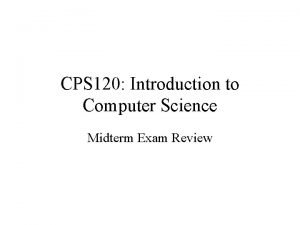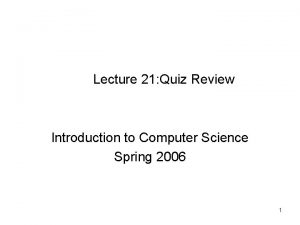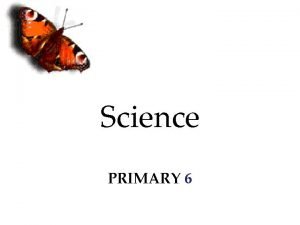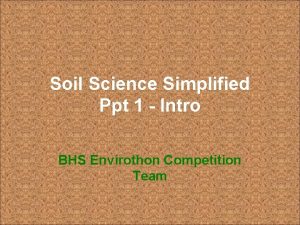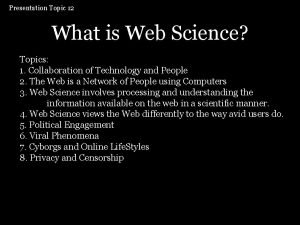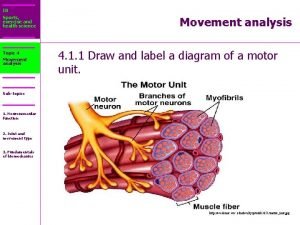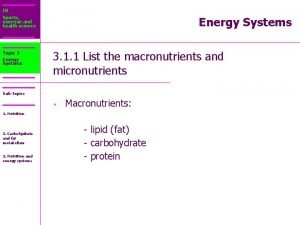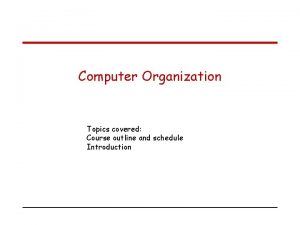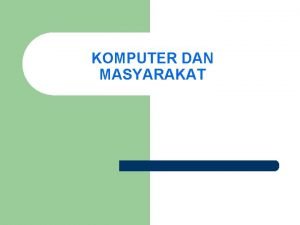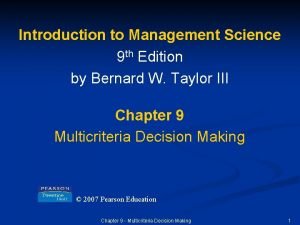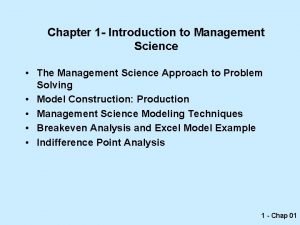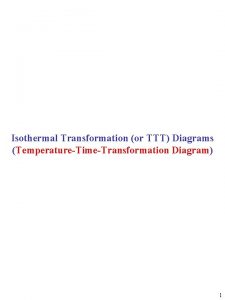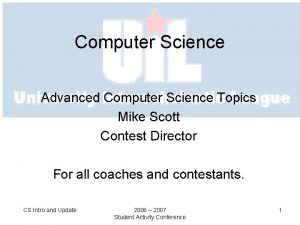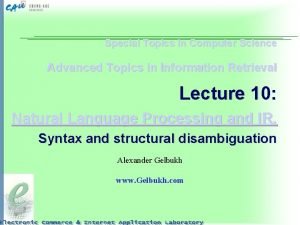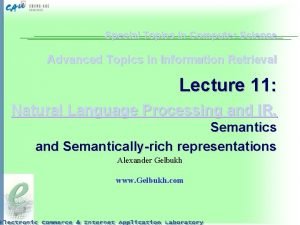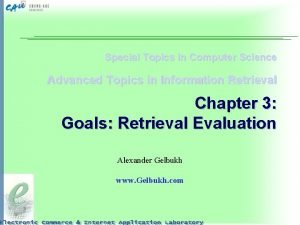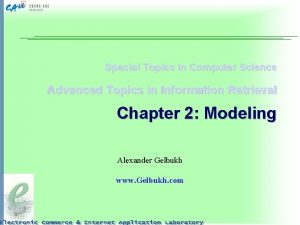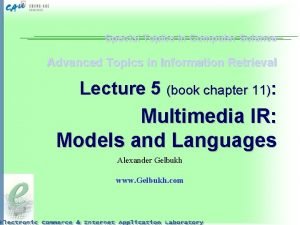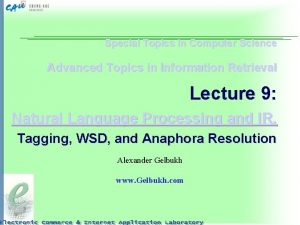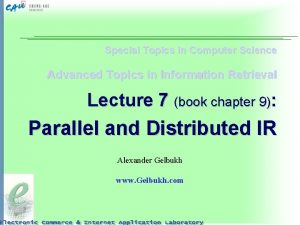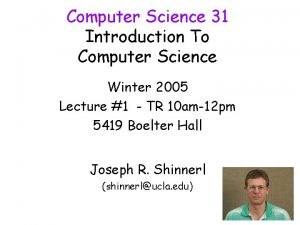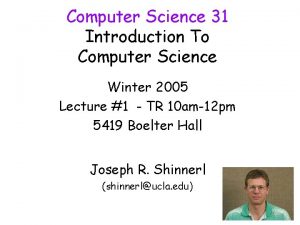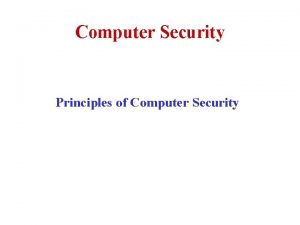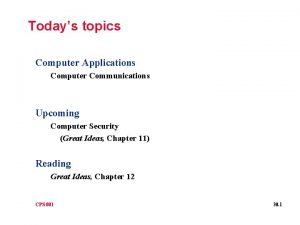An Introduction to Computer Science Chapter 1 Topics


















- Slides: 18

An Introduction to Computer Science Chapter 1 Topics: The Definition of Computer Science Algorithms CMPUT 101 Introduction to Computing (c) Yngvi Bjornsson 1

Misconceptions about Computer Science • Computer science is the study of computers. – “Computer science is no more about computers than astronomy is about telescopes, biology is about microscopes, or chemistry is about beakers and test tubes. Science is not about tools. It is about how we use them, and what we find out when we do”. CMPUT 101 Introduction to Computing (c) Yngvi Bjornsson 2

Misconceptions ( cont. … ) • Computer science is the study of how to write computer programs. – Programming is an important part of computer science, but so primarily as a tool to implement ideas and solutions. – A program is only a means to an end, not an end in itself. CMPUT 101 Introduction to Computing (c) Yngvi Bjornsson 3

Misconceptions ( cont. … ) • Computer science is the study of the uses and applications of computers and software. – Learning how to use a computer/software is no more part of computer science than driver’s education is a branch of automotive engineering. CMPUT 101 Introduction to Computing (c) Yngvi Bjornsson 4

What is Computer Science then? • The previous definitions: – although not necessarily (completely) wrong, are incomplete and thus misleading. • A more accurate definition: Computer science is the study of algorithms, including their properties, their hardware and linguistic realizations, and their applications. CMPUT 101 Introduction to Computing (c) Yngvi Bjornsson 5

OK, but what is an algorithm? • Formal definition: – A well-ordered collection of unambiguous and effectively computable operations that, when executed, produces a result and halts in a finite amount of time. • Or, more informally: A step-by-step method for accomplishing some task. CMPUT 101 Introduction to Computing (c) Yngvi Bjornsson 6

“Algorithms” in our Daily Life • Algorithms are not necessarily limited to specify mathematical tasks. • We use “algorithms” all the time in our daily life, for example: – Cooking recipes. – Instructions for assembling things. – Directions how to get to places. – When performing routine tasks. CMPUT 101 Introduction to Computing (c) Yngvi Bjornsson 7

An Algorithm for Shampooing Your Hair Ste p 1 2 3 4 5 6 Operation Wet your hair Lather your hair Rinse your hair Stop, you have finished shampooing your hair CMPUT 101 Introduction to Computing (c) Yngvi Bjornsson 8

An Algorithm for Calculating your GPA Ste p 1 2 3 4 5 6 7 8 Operation total_gp = 0 course_count = 0 Repeat steps 4 -5 for all your coursesi total_gp = total_gp + grade in coursei course_count = course_count + 1 GPA = total_gp / course_count Print the value of GPA Stop. CMPUT 101 Introduction to Computing (c) Yngvi Bjornsson 9

Aren’t all “instructions” then an algorithm? • … a well-ordered collection … – Must know in which order to perform the steps (matters whether you rinse or lather your hair first!). • …unambiguous and effectively computable operations … – must know specifically how to perform each step. • … that produces a result … – must be doing something well defined. CMPUT 101 Introduction to Computing (c) Yngvi Bjornsson 10

Algorithms and Problem Solving • We have a task or a problem that needs to be solved: • We want to translate the procedure for solving the problem into an algorithm that is: – Correct – Efficient – Each step is computable CMPUT 101 Introduction to Computing (c) Yngvi Bjornsson 11

Why bother? If we can specify an algorithm to solve a problem, then we can automate its solution. Step 1: … Step 2: … Step 3: … Problem Algorithm CMPUT 101 Introduction to Computing agent (c) Yngvi Bjornsson Solution 12

Computing Agent • A computing agent is an entity capable of performing the steps described in the algorithm, that is, execute the algorithm. • Could be a: – Person – DNA (!) – Computer • In our case, typically a computer. CMPUT 101 Introduction to Computing (c) Yngvi Bjornsson 13

Definition of Computer Science Computer science - the study of algorithms, including: 1) Their formal and mathematical properties 2) Their hardware realizations 3) Their linguistic realizations Step 1: … 4) Their applications Step 2: … Step 3: … Problem Algorithm CMPUT 101 Introduction to Computing agent. Solution (c) Yngvi Bjornsson 14

1) Formal and Mathematical Properties • Computer Science is about: – How to design algorithms to solve a wide range of problems. – How to determine whether problems are (efficiently) computable • That is, can be specified as an algorithm! – Studying the behavior of algorithms to decide whether they are correct CMPUT 101 Introduction to Computing (c) Yngvi Bjornsson 15

2) Their Hardware Realization • Computer Science is about: – Designing and building computer systems capable of executing algorithms. – Non-stopping technological advances: • Faster and faster computers, networks, … • Parallel computing • “Quantum computing”? CMPUT 101 Introduction to Computing (c) Yngvi Bjornsson 16

3) Their linguistic realizations • Computer Science is about: – Designing programming languages and translating algorithms into these languages so they can be executed by the hardware. • Functional programming • Object Oriented programming • Visual programming • … CMPUT 101 Introduction to Computing (c) Yngvi Bjornsson 17

4) Their applications • Computer Science is about: – Identifying important problems (new uses) for computers. – Designing software to solve these new problems. • New and new applications: – First computers were used mainly for numerical calculations and massive data storage/retrieval. – Then, … business use, graphics, multimedia, games, Internet, WWW, cars, house appliances, … CMPUT 101 Introduction to Computing (c) Yngvi Bjornsson 18
 Advanced topics in computer science
Advanced topics in computer science My favorite subject is english
My favorite subject is english Science fusion digital lessons
Science fusion digital lessons Introduction to computer science midterm exam
Introduction to computer science midterm exam Introduction to computer science midterm exam test
Introduction to computer science midterm exam test Introduction to computer science quiz
Introduction to computer science quiz Python programming an introduction to computer science
Python programming an introduction to computer science Primary 6 science
Primary 6 science Soil acidity ppt
Soil acidity ppt Science topics for presentation
Science topics for presentation Ib sports science topic 4
Ib sports science topic 4 Ib sports, exercise and health science topics
Ib sports, exercise and health science topics Computer organization course
Computer organization course Computer and society topics
Computer and society topics Computer science illuminated chapter 4 answers
Computer science illuminated chapter 4 answers Invitation to computer science chapter 10 answers
Invitation to computer science chapter 10 answers Introduction to management science chapter 5 solutions
Introduction to management science chapter 5 solutions Introduction to management science chapter 1 solutions
Introduction to management science chapter 1 solutions Introduction to materials science for engineers chapter 10
Introduction to materials science for engineers chapter 10



